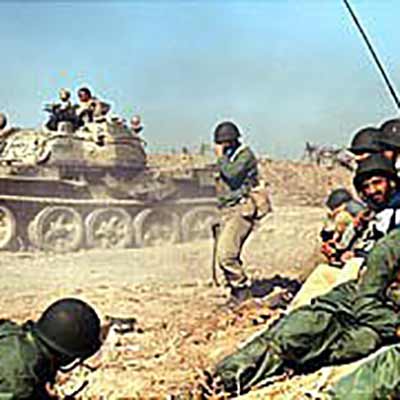Battles
Operation Valfajr 3
Leila Heydari Bateni
174 Views
Operation Valfajr 3 was launched on July 25, 1983, in Ilam Province, southwestern Iran. Aiming at clearing the Ilam–Mehran–Dehloran communication road and taking control of the border highlands, it ended successfully.
The failure of military operations in southern Iran in 1983 changed the Iranian military strategy, shifting the focus to carrying out operations in areas where Iraqi forces were less concentrated. In line with this new approach, operations Valfajr 2 and Valfajr 3 were launched in the western part of the country. To ensure an integrated command structure and coordination, the “Najaf Joint Operational Headquarters” was established in western Iran, and Zafar and Fath headquarters were placed under its command.[1] During the operation, two sub-headquarters, Fath 1 and Fath 2, comprising nine units from both the Islamic Republic of Iran Army and the Islamic Revolutionary Guard Corps (IRGC), were also commanded by Najaf Joint Operational Headquarters.[2] Therefore, the Najaf Headquarters was responsible for carrying out Operation Valfajr 3.[3]
The objectives of the operation included facilitating movement and ensuring security along the Ilam–Mehran–Dehloran Road, establishing defensive lines against the Iraqi army by positioning Iranian forces on the border heights, and preventing Iraqi troops from gaining a foothold in the Badreh Plain.[4]
The operation was conducted in Mehran, covering an area from the south of Kani-Sakht to the Qaleh-Avizan (Qalavizan) Heights in the east part of Mehran. Also, the forces would confront the enemy in Zalu-Ab, Namklanbu, the Duraji Outpost to Farrokhabad, and the Qalavizan Heights to Peak 175.[5] The northern highlands of the region were occupied by Iraqi forces, who had fortified their positions by controlling the Kal-e Qandi and Zalu-Ab heights and building various defensive structures. In the southern part of the region, which was a flat terrain, the Qalavizan Hills and surrounding areas were under Iranian control and served as key obstacles along the central front.[6]
The combat structure consisted of two tactical headquarters: Fath 1 and Fath 2. Fath 1 with the 5th Nasr and the 27th Muhammad Rasulullah (pbuh) divisions were engaged in the northern front. On the central front, there were the 21st Imam Reza (as) Brigade, 17th Imam Ali (as) Division, 114th Amir al-Muminin (as) Brigade, 84th Khorramabad Infantry Brigade, and a unit of Iraqi Mujahideen. Backed by the 41st Tharallah (as) and the 21st Hamzeh divisions, Fath 2 was handling the situation on the southern front.[7]
One division and one battalion from the Army Ground Forces also participated in the operation.[8] In addition, the Islamic Republic of Iran Army Aviation (Havanirooz), Army Ground Force artillery units, and Air Force pilots played significant roles in the operation.[9]
With some prior knowledge of the operation, Iraq deployed more than 12 divisions and 10 independent battalions to counter the Iranian forces.[10]
Operation Valfajr 3 began at 3:00 AM on July 29, 1983, with the code-name “Ya Allah, Ya Allah, Ya Allah, Ya Muhammad (pbuh), Ya Ali (as)”, and lasted for seventeen days.[11] Fath 1 and Fath 2 tactical headquarters carried out the operation with independent commands across the northern, central, and southern fronts. On the northern front, the 5th Nasr Division managed to besiege heights 305, 325, 340, and 343. On the second day of the operation, the Iranian units fortified their positions and liberated Hill 343 and the Duraji Road, which had been occupied by the enemy. To fully liberate the region’s heights, they launched multiple attacks. Due to the prolonged siege and the fierce resistance of the Iraqi army, the mission to liberate the besieged hills was handed over to the 27th Muhammad Rasulullah (pbuh) Division.[12] The Komeil Battalion of the Ammar Brigade, under the direct command of Mohammad Ebrahim Hemmat, commander of the division, engaged in the battle on August 7th and broke through the strong Iraqi resistance. One day later, the forces liberated Hills 325 and 340, and after eleven days of intense combat finally captured Hill 343, known as Kal-e Qandi, which had significant strategic importance.[13]
The central front extended from the Zalu-Ab Outpost to Farrokhabad. In the early hours of July 29th, despite the Iraqi army having built extensive defensive obstacles such as large anti-tank ditches and protective berms, Iranian forces succeeded in capturing outposts 2, 3, and 4 located along the eastern edge of the Kanjan Cham River. On the second night, following the liberation of Hill 343, the units of the 21st Imam Reza (as) Brigade destroyed two major Iraqi outposts on the right side of the Seyyed Qasem Outpost thereby enabling their counterparts in the central front to achieve the operation’s objectives.
On the southern front which included an area from Farrokhabad to Qalavizan, the commander assigned four battalions to four separate missions. They engaged in the battle on July 29th. These battalions were organized as follows: the Val-Asr Battalion was tasked with advancing from Farrokhabad towards the Seyyed Qasem Outpost; Hazrat-e Rasul (pbuh) and Ali Waliullah (as) battalions were responsible for Hill 175; Hussain ibn Ali (as) Battalion was assigned to Hill 223 of Qalavizan; and al-Mahdi (as) Battalion was engaged in the eastern part of the battlefield.
The Hussain ibn Ali (as) Battalion was unable to achieve its objectives due to early engagement with the enemy and the latter’s awareness of the operation. In areas where Val-Asr and Hazrat-e Rasul (pbuh) battalions were engaged, Iranian forces managed to surround Hill 175 of Qalavizan. However, the al-Mahdi (as) Battalion was unable to completely clear the passages and roads along its operational area. The Iraqi army had placed barbed wire at the front line and dug large anti-tank and anti-vehicle ditches thereby halting the Iranian forces’ movement. Thus, although the enemy’s position on the southern front was breached, the Iranian units could not fulfill their objectives. Only the units fighting on two fronts out of the four managed to move forward. Consequently, due to the lack of a connection between the forces engaging in different front lines and a shortage of ammunition, the operation commander ordered the Iranian troops on the southern front to retreat.[14]
Therefore, Operation Valfajr 3 concluded on August 15, 1983, after seventeen days.
Although one of the goals of Operation Valfajr 3—bringing Mehran and its surrounding villages out of enemy surveillance—was not achieved, and the forces on the southern front faced setbacks, the liberation of the northern and central areas and securing the Kanjan-Cham Pass were considered major successes.[15]
Other achievements of Operation Valfajr 3 included the liberation of Mehran, the capture of the Namkelanbu and Zalu-Ab heights, the liberation of the Mehran–Dehloran routes, and the linking of the central and southern fronts.[16] Several Iranian border outposts including Rezaabad and Farrokhabad, and some Iraqi posts such as Zalu-Ab and Duraji, along with 300 square kilometers of Iranian territory were liberated.[17]
According to the assessment of the Najaf Headquarters, about 60 percent of the operation’s objectives were achieved. Furthermore, the Mehran–Salehabad Road was partially cleared, and a significant portion of it was brought out of the enemy fire range.[18]
During this operation, about 5000 Iraqi soldiers were killed or wounded, and 400 were taken prisoner. In addition, 200 Iraqi tanks and armored personnel carriers, 6 helicopters and aircraft, and many vehicles were destroyed. Heavy damage was inflicted on Iraqi equipment and weaponry, and several of Iraq’s border guard units and infantry and armored brigades were wiped out.[19] On the Iranian side, 1020 were martyred or went missing during the operation.[20]
Between August 10–13, 1983, while Operation Valfajr 3 was still ongoing, and even during Operation Valfajr 2, which had taken place a month earlier—Iraq intensified its air raids on Iranian cities. By using cluster bombs and targeting civilian areas such as Gilan-e Gharb and Andimeshk, Iraq aimed not only to spread fear and panic but also to prevent Iranian forces from fighting on the frontlines.[21]
A commemoration ceremony for the martyrs of operations Valfajr 2 and Valfajr 3 and the bombed cities was held on August 15th at the Imam Khomeini (ra) Mosque in Tehran’s Grand Bazaar.[22]
About three years later, on June 30, 1986, Operation Karbala 1 was launched in the Mehran region, where Operation Valfajr 3 had been carried out.[23]
[1] Jafari, Mojtaba, Atlas-e Nabardha-ye Mandegar (Atlas of Enduring Battles), Tehran: Soreh Sabz, 35th ed., 1393, p. 90; Keyhan-Panah, Amir Hussain, Atlas-e Rahnama 10: Mehran dar Jang (Atlas 10: Mehran in the War), Tehran: Markaz-e Asnad va Tahqiqaat-e Defa Muqaddas, 1390, p. 50.
[2] Ardestani, Hussain, Tajzieh va Tahlil-e Jang Iran va Araq, vol. 3: Tanbih-e Motajavez (Analysis of the Iran-Iraq War, Vol. 3: Punishing the Aggressor), Tehran: Markaz-e Motaleat va Tahqiqaat-e Jang, 1379, p. 56.
[3] Jafari, Mojtaba, Atlas-e Nabardha-ye Mandegar (Atlas of Enduring Battles), p. 88; Keyhan-Panah, Amir Hussain, Atlas-e Rahnama 10 (Atlas 10), p. 50.
[4] Keyhan-Panah, Amir Hussain, Atlas-e Rahnama 10 (Atlas 10), p. 50.
[5] Ardestani, Hussain, Tajzieh va Tahlil-e Jang Iran va Araq (Analysis of the Iran-Iraq War), Vol. 3, p. 56.
[6] Keyhan-Panah, Amir Hussain, Atlas-e Rahnama 10 (Atlas 10), p. 52.
[7] Ibid., Pp. 50-51.
[8] Ardestani, Hussain, Tajzieh va Tahlil-e Jang Iran va Araq (Analysis of the Iran-Iraq War, Vol. 3, p. 56.
[9] Jafari, Mojtaba, Atlas-e Nabardha-ye Mandegar (Atlas of Enduring Battles), p. 90.
[10] Keyhan-Panah, Amir Hussain, Atlas-e Rahnama 10 (Atlas 10), p. 56.
[11] Karimi, Nabi, Taqvim-e Tarikh-e Defa Muqaddas, Vol. 36: Valfajr 3 (Calendar of Sacred Defense History, Vol. 36: Valfajr 3), Tehran: Markaz-e Asnad-e Enqelab-e Eslami, 1395, p. 9.
[12] Keyhan-Panah, Amir Hussain, Atlas-e Rahnama 10 (Atlas 10), p. 60.
[13] Rashid, Mohsen, Atlas-e Jang Iran va Araq (Atlas of the Iran-Iraq War), Tehran: Markaz-e Motaleat va Tahqiqaat-e Jang, 1379, p. 59; Keyhan-Panah, Amir Hussain, Atlas-e Rahnama 10 (Atlas 10), p. 60.
[14] Keyhan-Panah, Amir Hussain, Atlas-e Rahnama 10 (Atlas 10), Pp. 64-54.
[15] Ibid., p. 68.
[16] Rashid, Mohsen, Atlas-e Jang Iran va Araq (Atlas of Iran-Iraq War), p. 59.
[17] Jafari, Mojtaba, Atlas-e Nabardha-ye Mandegar (Atlas of Enduring Battles), p. 88.
[18] Keyhan-Panah, Amir Hussain, Atlas-e Rahnama 10 (Atlas 10), p. 68.
[19] Jafari, Mojtaba, Atlas-e Nabardha-ye Mandegar (Atlas of Enduring Battles), p. 88.
[20] Keyhan-Panah, Amir Hussain, Atlas-e Rahnama 10 (Atlas 10), p. 68.
[21] Rooznama-ye Etelaat (Etelaat Newspaper), No. 17083, 23 Mordad 1362, p. 2.
[22] Karimi, Nabi, Taqvim-e Tarikh-e Defa Muqaddas (Calendar of Sacred Defense History), Vol. 36, p. 1495.
[23] Hajji Khodavardikhah, Mahdi, Roozhshomar-e Jang Iran va Araq, Vol. 42, Vol. 2: Azadi-ye Mehran (Day-by-Day Record of the Iran-Iraq War, Vol. 42, Vol. 2: Liberation of Mehran), Tehran: Markaz-e Asnad va Tahqiqaat-e Defa Muqaddas Sepah, 1397, p. 496.





